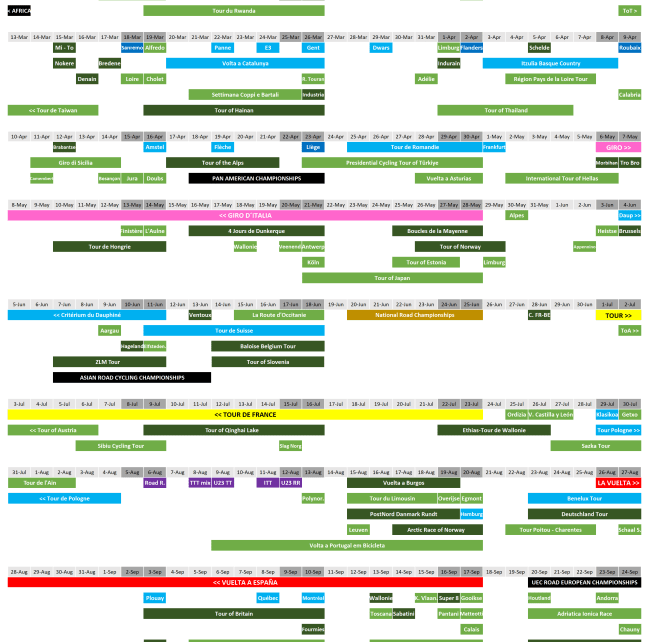The 2023 race calendar breaks with tradition by moving the World Championships to early August, between the Tour de France and the Vuelta a España. This will also be the year in which an extensive calendar of races outside Europe returns, and several races will be born that will make the season more interesting. In this article, we will analyse all the changes and enable you to download the race calendar to follow the frenetic activity of the season more easily.
The Calendar
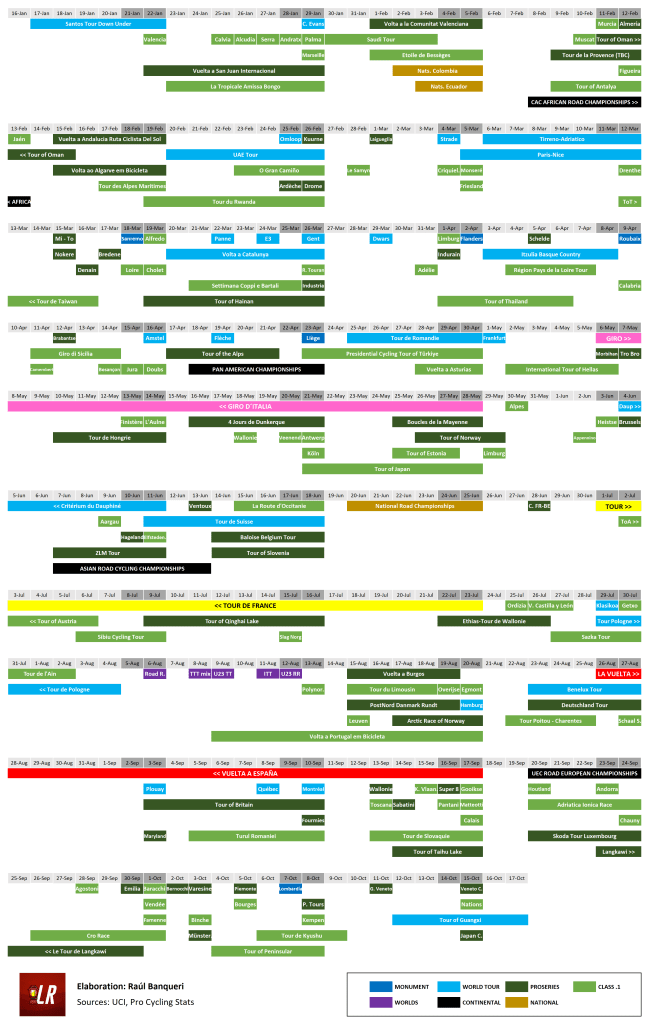
In the image, you can see the complete men’s calendar for the 2023 season, which will hopefully end on October 17 with the Tour of Guangxi, cancelled the last 3 years. We recommend downloading it in high resolution through the links below. We also provide links to download each quarter separately. The images can be printed to paste on the wall of your bedroom, for example, should you wish to absorb the glorious calendar even in the midst of sleep.
High resolution images:
Quarter 1:
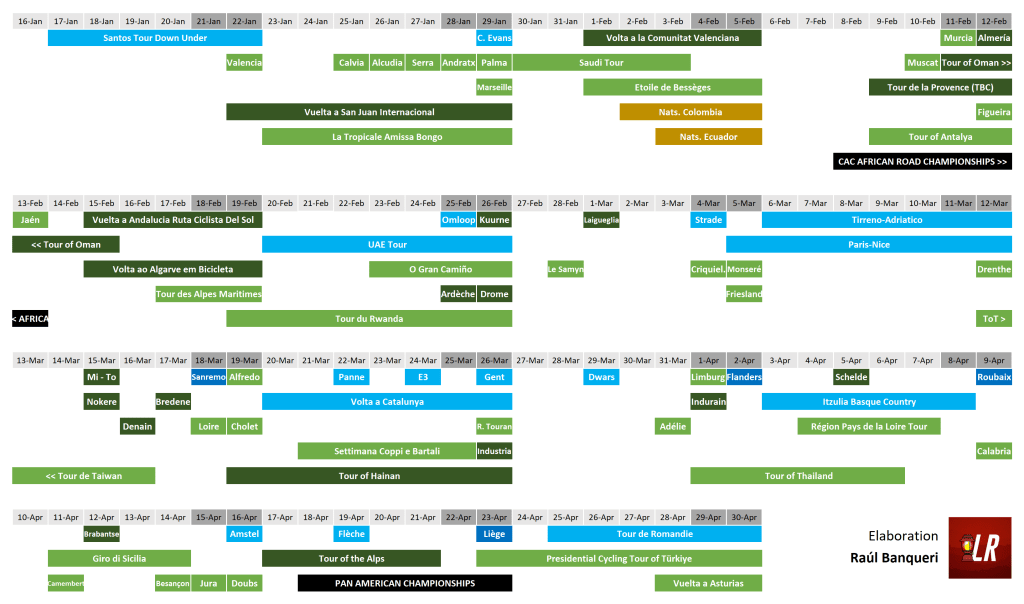
In January, we have the return of the Australian races, the Vuelta a San Juan and La Tropicale Amissa Bongo, early season classics that have not been contested since 2020. In addition, the Clàssica Comunitat Valenciana is upgraded to category 1.1 (the lowest category that allows the participation of WorldTeams) and will inaugurate the season in Europe. The Grand Prix Criquielion (March 4) and the Elfstedenrace Friesland (March 5) are also promoted to category 1.1.
In the new races section, there are three new classics that will take advantage of synergies in the calendar: the Muscat Classic (February 10, one day before the start of the Tour of Oman), the Figueira Champions Classic (February 12, three days before the start of the Volta ao Algarve) and the Giro della Città Metropolitana di Reggio Calabria (April 9, two days before the start of the Giro di Sicilia). Also the Tour du Doubs (usually in September), will be brought forward to April 16 to form a triptych of one-day races in France. Thanks to their placement in the calendar, these four races will be able to attract a good participation of teams looking to optimise their logistics.
On the other hand, the Tour of Türkiye (WorldTour until 2019 and ProSeries until 2022) has been downgraded to the 2.1 category, taking away the attraction of the UCI points it was handing out. Surely, its startlist will be greatly affected by this.
Quarter 2
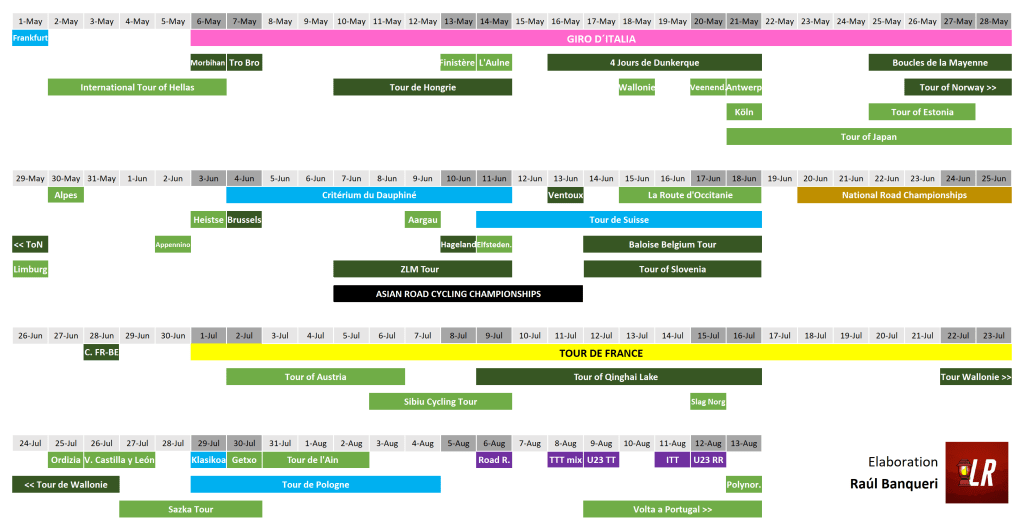
In the second part of the season there are no new races, but the Tour de Hongrie (May 10-14) and the Mont Ventoux Challenge (June 13) are upgraded to the ProSeries category, being able to host more WorldTeams and distributing more UCI points. Another ProSeries race, the Tour of Norway (May 26-29), will be reduced to only 4 stages compared to 6 in the previous edition. In addition, the Circuit Franco-Belge (1.Pro), usually at the end of the season, will be moved to June 28 to avoid overlapping with other races.
Anyway, the main change is the World Championships in August. This will only be the case every four years (in the Olympic year), when the “Super World Championships” will be organised, bringing road cycling together with the rest of cycling disciplines. These road World Championships will be especially strange, as the men’s elite road race will be held before the time trials and the women’s and U23 events. The Tour de France seems the best option to prepare for the men’s elite road race, as there are not many alternative races to get into the rhythm of competition.
Quarter 3
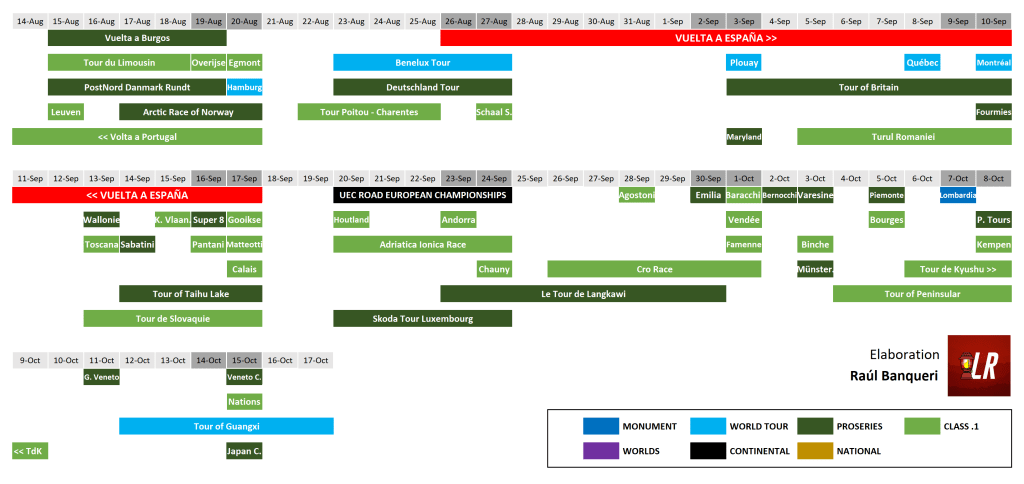
The change of dates for the World Championships has caused La Vuelta to be delayed by a week and the European Championships to take the place of the World Championships. We are likely to see a colder than normal Vuelta a España, as the race will take place in northern Spain in September. In addition, the one-week delay means that the final week of La Vuelta will overlap with a multitude of Italian and Belgian classics, which will reduce their media impact and the quality of their startlist. In this context of race saturation, the Benelux Tour, which was already cancelled in 2022, is reduced to only five stages in 2023. We will see if the race will continue to maintain WorldTour status in the future with so many organisational problems.
But there is also good news at the end of the season. The Clàssica Andorra Pirineus (September 23) and the Tour of Kyushu (October 6 to 9 in Japan) are born. The Tour of Kyushu may attract several teams that will participate the following week in the Japan Cup. In addition, the Trofeo Baracchi (October 1), organized from 1941 to 1991 and won by Eddy Merckx, Fausto Coppi or Jacques Anquetil, returns. This one-day race has the format of a time trial in couples, differentiating it from the other events on the cycling calendar. Also in Italy, the Giro del Veneto (October 11) and the Veneto Classic (October 15) are promoted to the ProSeries category. Both races are organised by former cyclist Filippo Pozzato.
For its part, Le Tour de Langkawi (2.Pro) will be maintained at the end of the season after last year’s success and will be linked with the Tour of Peninsular 2.1 (also in Malaysia, its only edition was in 2019). Thus, they will offer 13 days of competition combining the two races, an attraction for modest teams suffering to participate in a large calendar.
This calendar is provisional and may still be subject to cancellations or variations of dates during the season. The return of the Chinese races will depend on the pandemic situation. We wish you a happy season!
